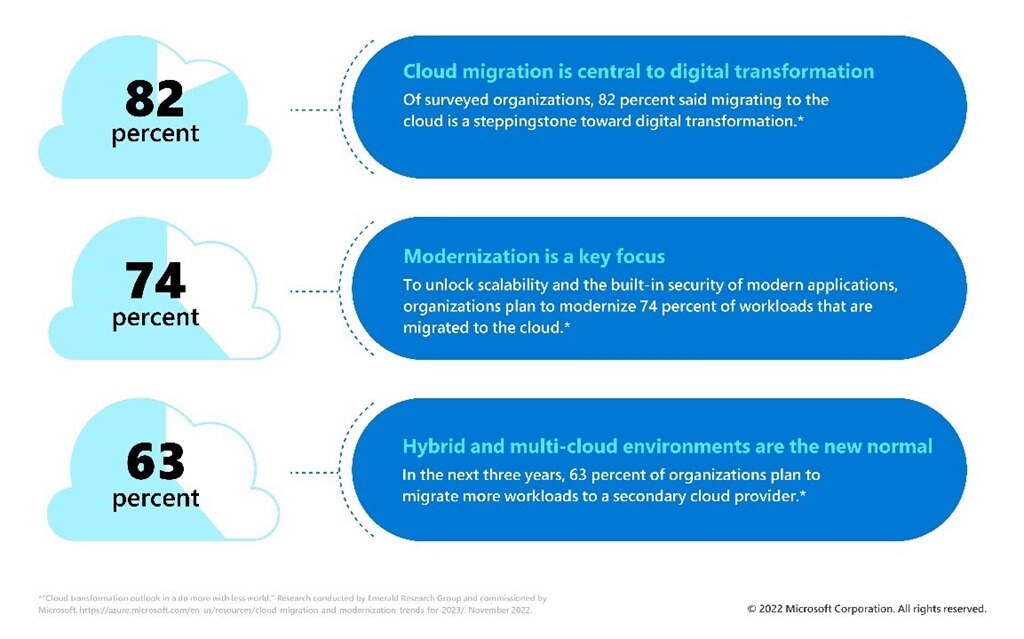Major Trends in Migrating and Modernizing Workloads to the Cloud - Course Monster Blog

Over the past few years, organizations have faced significant challenges as they have had to adapt to economic, political, and societal changes. Migrating and Modernizing Workloads, These challenges are not over yet, as the business environment remains uncertain and there are ongoing concerns such as inflation, supply chain disruptions, and rising energy costs.
Microsoft believes that organizations can best navigate this uncertainty by doing more with fewer resources, such as reducing complexity and cost while increasing agility, resilience, and innovation. This can be achieved through the use of digital technologies to achieve more despite current limitations.
Migrating workloads to the cloud allow organizations to better align their IT investments with business needs while taking advantage of the cost savings provided by cloud economies of scale. Modern infrastructure and cloud capabilities can also enable an organization’s IT workforce to focus on the workloads and applications that are most important to their customers.
To gain insight into the challenges faced by our customers and their plans for cloud adoption, Microsoft conducted a global survey with over 1200 IT decision-makers.
Migrating and Modernizing Workloads: The study revealed three key cloud adoption trends

1. Cloud adoption plans remain integral to strategies in uncertain business climates
According to the survey, 62% of organizations have a migration and modernization strategy in place, demonstrating the growing importance of cloud adoption in IT transformation. The top motivators for these organizations are reducing overall business costs, future-proofing business strategy, and driving revenue growth. The survey also showed that security, business continuity, disaster recovery, and scalability are among the top benefits desired from cloud migrations. Despite these benefits, Microsoft expects that return on investment will continue to be a top consideration for customers as they prioritize cloud initiatives, whether it be optimizing their existing cloud workloads or moving additional workloads to the cloud. This focus on cost optimization and the rise of financial operations teams (FinOps) is also reflected in the Flexera State of the Cloud 2022 report, which found that optimizing the existing use of the cloud (cost savings) was the top initiative for the sixth year in a row, followed by migrating more workloads to the cloud.
Organizations are taking a comprehensive approach to their cloud adoption plans by evaluating their entire IT infrastructure to better prepare for the future. According to the survey, the number of organizations with more than half of their workloads in the cloud will increase from 27% to 47% over the next 18 months, with investments covering both business-critical and non-business-critical workloads. Additionally, the survey found that organizations with a cloud migration and modernization strategy are 58% more likely to be “cloud-only” (with all or nearly all applications and workloads running in the cloud) three years from now.
2. Modernization is a key focus for digital transformation
According to the survey, 82% of organizations said that migrating to the cloud is a stepping stone toward digital transformation. Migrating and modernizing workloads to the cloud are about moving them to a new platform, while modernization involves adapting existing applications and workloads to take advantage of cloud-native technologies like Platform-as-a-Service (PaaS) or containers. Of the workloads that have already been migrated, 74% were identified as candidates for modernization. Modernizing workloads can facilitate digital transformation, whether by speeding up product innovation cycles or providing personalized end-user experiences.
3. Hybrid and multi-cloud interoperability and integration are expected
Organizations are continuing to adopt multi-cloud approaches and are looking for cross-cloud management and interoperability from their cloud providers. According to our recent research on hybrid and multi-cloud, 71% of customers surveyed want to retain investment flexibility and access the best cloud capabilities and are planning to implement a hybrid or multi-cloud strategy.
There are several barriers that can slow down cloud adoption, including the complexities of cloud-to-cloud integration, adapting existing applications, and integrating with legacy systems. It is therefore not surprising that support from a dedicated migration and modernization team was the top priority for customers surveyed in terms of their wishes from cloud vendors. Other important areas identified in the survey included post-migration support, access to engineering resources, and assistance with technical skills development. These findings have significant implications for cloud providers as they develop programs and investments to support customers during these uncertain times.
How Microsoft Azure can help customers with cloud Migrating and Modernizing Workloads efficiently
Microsoft has been undergoing its own digital transformation journey since we started migrating on-premises workloads to the cloud in 2014. We have used the built-in tools and data insights provided by Azure to optimize costs (such as Azure Advisor, Azure Cost Management and Billing, and Azure Monitor) and reinvest in modernization to drive business growth. Today, more than 95% of our workloads run on the cloud, and while our annual budget for Azure has remained constant since 2014, Microsoft has grown by more than 20%. Our own experience and insights inform how we can help customers meet their current and future technology needs.
Fiserv, a global fintech and payment company, improved its payment processing infrastructure to streamline operations, reducing risk and saving costs. Perrigo, a worldwide producer, and supplier of consumer self-care products for businesses, gained agility and flexibility by modernizing finance workloads to create a single source of truth for finance. The Bank of Angola became the first bank in Angola to embrace digital transformation by moving to the cloud to innovate and improve processes and infrastructure. O2 Czech Republic, the leading telecommunications company in the Czech Republic, achieved 30% total cost of ownership (TCO) savings for every workload they migrated while improving security and scaling their entertainment business.
Want to know more about Microsoft? Visit our course now.
How about Azure? We have here covered for you as well.
Microsoft is committed to helping our customers get the most out of their Azure investments by providing solutions that enable them to do more with fewer resources.
- Microsoft is introducing a new total cost of ownership (TCO) or business case tool that helps customers estimate the savings they can achieve by migrating their Windows Server and SQL Server estate to Azure. This tool will be available within Azure Migrate, our free self-service migration tool that enables organizations to plan and execute their move to Azure. You can try out this new capability and share your feedback.
- Customers can optimize their cloud investments with their unique offers and pricing benefits. For example, the Azure Hybrid Benefit allows customers to save costs by using their software assurance-enabled Windows, Server SQL Server, Red Hat Enterprise Linux, and SUSE Linux licenses on Azure, while Extended Security Updates are free only on Azure. Running Windows Server and SQL Server VMs on Azure is up to 80% less expensive than with our main competitor. Additionally, with the Azure savings plan for computing, customers can significantly reduce resource costs by up to 65% compared to pay-as-you-go prices.
- The Azure Migration and Modernization Program (AMMP) offers a range of expert assistance to help customers reduce migration costs and speed up their transition to Azure, including technical training, engineering resources, specialized partners, and cost-effective incentives.
Microsoft is dedicated to helping our customers succeed, achieve strong business results, and maximize their return on investment in the cloud, especially during difficult times like the present.
Here at CourseMonster, we know how hard it may be to find the right time and funds for training. We provide effective training programs that enable you to select the training option that best meets the demands of your company.
For more information, please get in touch with one of our course advisers today or contact us at training@coursemonster.com




Comments ()